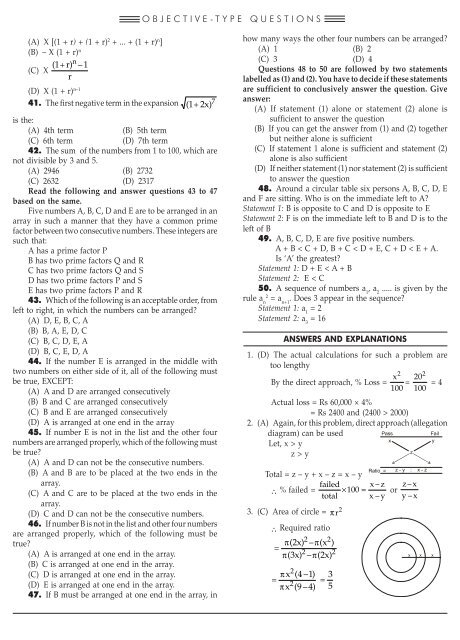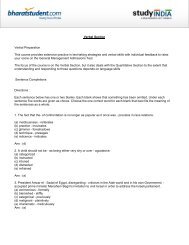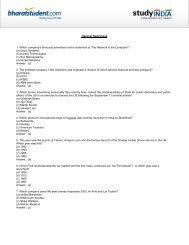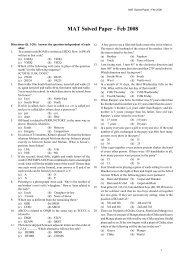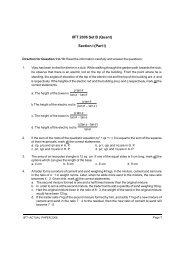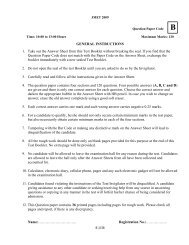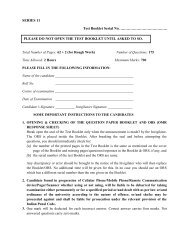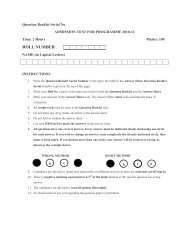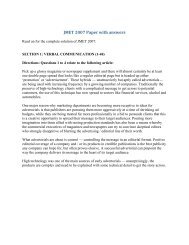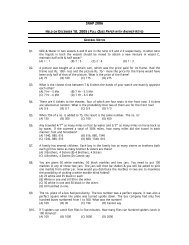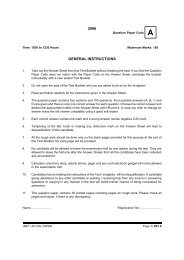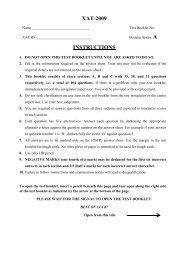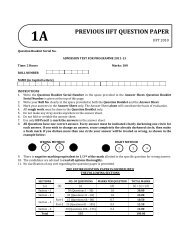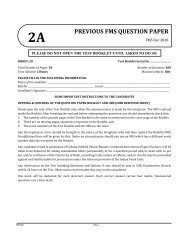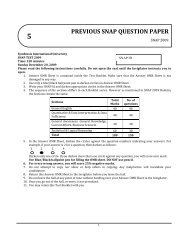QUANTITATIVE APTITUDE
QUANTITATIVE APTITUDE
QUANTITATIVE APTITUDE
Create successful ePaper yourself
Turn your PDF publications into a flip-book with our unique Google optimized e-Paper software.
(A) X [(1 + r) + (1 + r) 2 + ... + (1 + r) n ]<br />
(B) – X (1 + r) n<br />
n<br />
( 1+ r)<br />
– 1<br />
(C) X<br />
r<br />
(D) X (1 + r) n–1<br />
41. The first negative term in the expansion ( 1 2 ) 7<br />
+ x<br />
is the:<br />
(A) 4th term (B) 5th term<br />
(C) 6th term (D) 7th term<br />
42. The sum of the numbers from 1 to 100, which are<br />
not divisible by 3 and 5.<br />
(A) 2946 (B) 2732<br />
(C) 2632 (D) 2317<br />
Read the following and answer questions 43 to 47<br />
based on the same.<br />
Five numbers A, B, C, D and E are to be arranged in an<br />
array in such a manner that they have a common prime<br />
factor between two consecutive numbers. These integers are<br />
such that:<br />
A has a prime factor P<br />
B has two prime factors Q and R<br />
C has two prime factors Q and S<br />
D has two prime factors P and S<br />
E has two prime factors P and R<br />
43. Which of the following is an acceptable order, from<br />
left to right, in which the numbers can be arranged?<br />
(A) D, E, B, C, A<br />
(B) B, A, E, D, C<br />
(C) B, C, D, E, A<br />
(D) B, C, E, D, A<br />
44. If the number E is arranged in the middle with<br />
two numbers on either side of it, all of the following must<br />
be true, EXCEPT:<br />
(A) A and D are arranged consecutively<br />
(B) B and C are arranged consecutively<br />
(C) B and E are arranged consecutively<br />
(D) A is arranged at one end in the array<br />
45. If number E is not in the list and the other four<br />
numbers are arranged properly, which of the following must<br />
be true?<br />
(A) A and D can not be the consecutive numbers.<br />
(B) A and B are to be placed at the two ends in the<br />
array.<br />
(C) A and C are to be placed at the two ends in the<br />
array.<br />
(D) C and D can not be the consecutive numbers.<br />
46. If number B is not in the list and other four numbers<br />
are arranged properly, which of the following must be<br />
true?<br />
(A) A is arranged at one end in the array.<br />
(B) C is arranged at one end in the array.<br />
(C) D is arranged at one end in the array.<br />
(D) E is arranged at one end in the array.<br />
47. If B must be arranged at one end in the array, in<br />
OBJECTIVE-TYPE QUESTIONS<br />
how many ways the other four numbers can be arranged?<br />
(A) 1 (B) 2<br />
(C) 3 (D) 4<br />
Questions 48 to 50 are followed by two statements<br />
labelled as (1) and (2). You have to decide if these statements<br />
are sufficient to conclusively answer the question. Give<br />
answer:<br />
(A) If statement (1) alone or statement (2) alone is<br />
sufficient to answer the question<br />
(B) If you can get the answer from (1) and (2) together<br />
but neither alone is sufficient<br />
(C) If statement 1 alone is sufficient and statement (2)<br />
alone is also sufficient<br />
(D) If neither statement (1) nor statement (2) is sufficient<br />
to answer the question<br />
48. Around a circular table six persons A, B, C, D, E<br />
and F are sitting. Who is on the immediate left to A?<br />
Statement 1: B is opposite to C and D is opposite to E<br />
Statement 2: F is on the immediate left to B and D is to the<br />
left of B<br />
49. A, B, C, D, E are five positive numbers.<br />
A + B < C + D, B + C < D + E, C + D < E + A.<br />
Is ‘A’ the greatest?<br />
Statement 1: D + E < A + B<br />
Statement 2: E < C<br />
50. A sequence of numbers a , a ..... is given by the<br />
1 2<br />
2 rule a = an+1 . Does 3 appear in the sequence?<br />
n<br />
Statement 1: a = 2 1<br />
Statement 2: a = 16 3<br />
ANSWERS AND EXPLANATIONS<br />
1. (D) The actual calculations for such a problem are<br />
too lengthy<br />
By the direct approach, % Loss = x2<br />
2<br />
20<br />
= = 4<br />
100 100<br />
Actual loss = Rs 60,000 × 4%<br />
= Rs 2400 and (2400 > 2000)<br />
2. (A) Again, for this problem, direct approach (allegation<br />
diagram) can be used<br />
Pass Fail<br />
x y<br />
Let, x > y<br />
z<br />
z > y<br />
Total = z – y + x – z = x – y<br />
∴ % failed = failed x– z z– x<br />
× 100 = or<br />
total x– y y– x<br />
3. (C) Area of circle = πr 2<br />
∴ Required ratio<br />
= π π<br />
2 2<br />
( 2x)<br />
– ( x )<br />
2 2<br />
π( 3x) – π(<br />
2x)<br />
= π<br />
2<br />
x ( 4– 1)<br />
2<br />
πx<br />
( 9– 4)<br />
= 3<br />
5<br />
Ratio =<br />
z - y : x - z<br />
x x x


